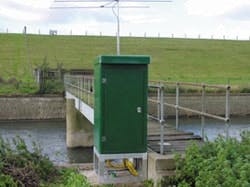Monitoring the Water Quality of the Thames
The water quality of the River Thames has affected the activities of mankind for centuries. In 1858, Parliament was suspended because of a stench arising from pollution in the river. Today, the noses of Members of Parliament are no longer necessary to detect water pollution; a network of sixty highly sophisticated monitoring stations relay live water quality data to the Environment Agency (EA).
Stretching 215 miles, the Thames is the longest river contained only in England, and its water quality is constantly under threat. The EA's Matt Loewenthal believes that the River Thames and its major tributaries are monitored more closely than any other river in the world.
"The decline of manufacturing industry in the region, coupled with investments and improvements in wastewater treatment systems, have undoubtedly contributed to an overall improvement in Thames river water quality,” said Loewenthal, who manages the EA’s automated water quality monitoring network in the Thames region.
“However, we regularly record pollution incidents that arise from [combined sewer overflows]. These are detected by sudden sags in dissolved oxygen, often in conjunction with a rise in ammonium."
Combined sewer overflow (CSO) refers to the discharge of untreated wastewater from a sewer system during rainstorms that carries both sewage and storm water. The increased flow caused by the storm water runoff exceeds the sewer system’s capacity, and the sewage is forced to overflow into streams and rivers through outfalls.
London’s 140-year-old sewage system is often unable to cope with the combined flow, especially as rainfall patterns change and urban development increases.
Of the 57 CSOs in London, 36 are considered “unsatisfactory” in terms of frequency of discharge and environmental impact. Even during periods of moderate rainfall, the overflows discharge storm water and sewage into the Thames once a week on average. Around 20 million cu meters of untreated sewage is discharged into the Thames every year.
Urban development, such as new housing, roads and the creation of nonporous parking areas in residential areas, has contributed to the increasing levels of rainfall rapidly entering the drainage system. However, sustainable urban drainage systems (SUDS) are now a feature in many new developments, and these initiatives will help to prevent the sudden surges of influent at wastewater treatment plants.
Still, Loewenthal said, the Thames’ water quality has reached a ”tipping point”.
"The River Thames and its major tributaries are the primary water resources in a catchment with a population in excess of 12 million people,” he said. “There are over 3,000 licensed abstractions of water, accounting for approximately 55% of effective precipitation. In addition, there are over 10,000 consents to discharge sewage or trade effluent into the catchment. This means that, in terms of rainfall versus abstraction, the Thames is the most heavily used river in Britain."
He added: "At the same time, climate change is creating more erratic weather conditions, and London is located in one of the driest parts of Britain with annual rainfall of 750 mm (29.53 in.). This heightens the significance of CSOs, and the decision to construct a ?2 billion-plus (approximately $3.67 billion) underground tunnel to deal with the discharge from 36 London CSOs has not come a moment too soon.”
Tideway Tunnel
The UK Government gave permission for the Tideway Tunnel in March 2007. The storage-and-transfer tunnel will run beneath the Thames from Hammersmith in West London and convey the discharges for collection and treatment in east London.
The new tunnel is not set for completion until 2020, and Loewenthal believes that water quality monitoring will play a vital role in the intervening period. "Even after the tunnel is finished," he said, "there will still be an important role for monitoring to play in the protection of the Thames from illegal discharges and failures to comply with discharge consents."
The Process
Each station collects water quality data from a YSI water quality sonde, which incorporates a number of sensors into an instrument no larger than 2 ft of an average drainpipe, and is designed to be unattended for considerable periods of time.
Collected water quality data is transmitted to EA offices via telemetry. Normally, YSI provides radio, mobile phone or satellite telemetry; however, the EA in the Thames Region already operates a real-time system based on Meteorburst.
Data is transmitted via Meteorburst by bouncing signals off ionized particles high in the atmosphere that result from meteorite activity. Using this method, it is possible to transmit data over distances of up to 600 km (372.8 miles). Water quality data is collated centrally and can be accessed through the regional telemetry system or the Internet for selected stakeholders.
A pump within the AWQMS draws river water into a chamber that contains the sonde over a period of 4 minutes. This ensures the sample is representative before a reading is taken from each of the sensors. Once a reading has been taken, the pump stops and backflushes to prevent any solids buildup.
The telemetry unit then transmits the data, and the master station at Newbury or Crystal Palace automatically sends a return message once it has received and checked it. The data is then wiped from the telemetry unit until the next set.
Advantages of Continuous Monitoring
In contrast to spot sampling, continuous monitoring is able to detect pollution at any time.
Each sonde is loaded with sensors, such as dissolved oxygen, temperature, pH, conductivity, turbidity, ammonium, blue-green algae and chlorophyll, so it is able to detect pollution from almost any source.
One important benefit of an integrated system that monitors an entire catchment is the ability to track events like algae blooms using chlorophyll and blue-green algae sensors. Coupled with data from the turbidity and ammonium probes, this is very useful information for intake protection at water treatment plants. Operators may shut down intakes if algae or ammonia levels are too high, for example, and a network like the one on the Thames is able to provide advance warning of pollution.
